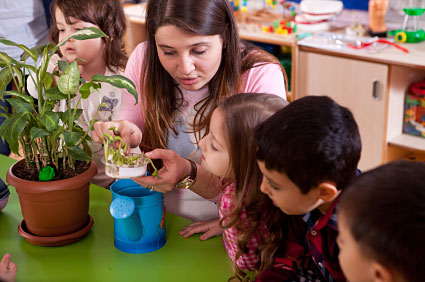When preschoolers sprout seeds indoors, they can find out about the first stages of plant growth. The sprouted plants can later be placed in the garden outdoors or kept inside. Here are some suggestions for seed-sprouting activities.
Find out what the children understand about how seeds become plants.
- Keep track of children’s ideas and questions on a topic web, list, or chart. You can add to it as they find answers to their questions.
- Share books that explain such words as germinate, sprout, and seedling. Find books and online resources with pictures that label roots, stems, leaves, and other plant parts.
Help the children start some plants indoors.
- Choose two to three kinds of seeds to bring in so that the class will be able to compare the ways the different seeds sprout and develop.
- Provide potting soil and cups or pots. Let children plant one kind of seed per pot. Have them put the pots where they can get sunlight. (Note: You might offer “peat pots,” small containers made of pressed peat moss. Children can set peat pots into garden soil later when the seedlings are ready, without disturbing the roots.)
- Show children how to sprout seeds without soil in sandwich bags, damp paper towels, or glass jars. You can find directions in books or online.
- Pose some questions: “Do you think all of your sprouts will look alike?” “How many days do you think it will take for the beans to sprout?”
Encourage children to keep track of plant growth.
- Offer magnifiers so that children can look closely at the sprouting seeds.
- Have a small group of children keep track of what happens to the seeds planted in pots. Another group can record what happens to the seeds that were started without soil. Encourage the children to draw or photograph what they see.
- Provide rulers, tape measures, and centimeter cubes, etc., so that children can measure seedling growth. Help them make charts of the changes.
- Each day, ask children to predict what the seeds or sprouts will look like the next time they observe. Help them follow up on their predictions: “You predicted that flowers would pop up today. Did you notice flowers in the pots?”
Invite children to represent what they have found out about sprouting seeds.
- Let children select drawings and photographs to display on a bulletin board or in a book.
- Ask children to dictate reports about seed sprouting to add to the bulletin board or the book.
- Provide materials for making models of the new plants, such as clay, pipe cleaners, and paper. Help the children label the parts of their model plants.
IEL Resource
- Resource List: Appreciating the Natural World with Young Children


 PDF
PDF